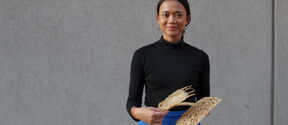Aalto University presents six concepts on renewable biomaterials at Dutch Design Week
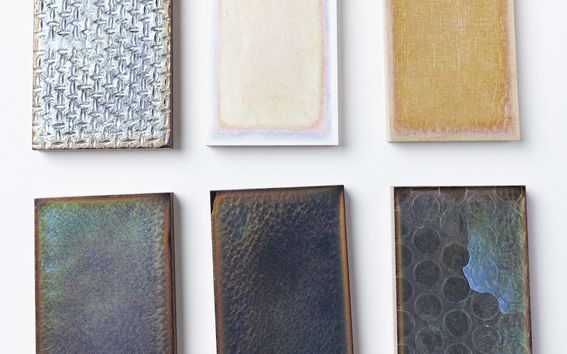
What if we could replace plastic and harmful chemicals with wood and cellulose based materials? Prototypes developed at Aalto University may offer future alternatives to plastic and fossil materials.
Aalto's CHEMARTS exhibition showcases future-oriented concepts on bio-based materials with prototypes at Dutch Design Week at the end of October. The exhibited projects are all-cellulose composites, structural colour made of wood, Ioncell textile fibre, zero-waste tomatoes, biodegradable 3D shapes and chicken feathers glued with nanocellulose.
‘In a circular economy, materials are not only reused or recycled; they are merely stored in products and then used again and again’, says Professor Pirjo Kääriäinen of Aalto University. ‘When designers and scientists join forces already at the early stage of materials research, new plant-based materials can be designed and developed for these closed-loop systems', she adds.
The concepts and designers:

Layers of Blue - Anna van der Lei & Anna-Mari Leppisaari
Creative explorations with wood-based materials and dyer's woad
All cellulose composites are eco-friendly and new functional materials with robust mechanical properties which could, for example, replace some plastics. The knit samples and hard blocks are made of 100% cellulose, and all cellulose composite materials are fully biobased and biodegradable, with no extra chemicals.
Some of the knits are treated with green ionic solvent, which includes partly dissolved cellulosic textile fibres that are ‘glued’ together. By varying processing conditions, the material properties can be modified from soft and flexible to strong and rigid, from hydrophilic to hydrophobic.
Team: Designers Anna-Mari Leppisaari & Anna van der Lei, Professor Tatiana Budtova & PhD student Chen Feng, Aalto University School of Chemical Engineering (all-cellulose composite), Professor Kirsi Niinimäki and the team at Aalto University School of Arts Design and Architecture (Dyer’s Woad)
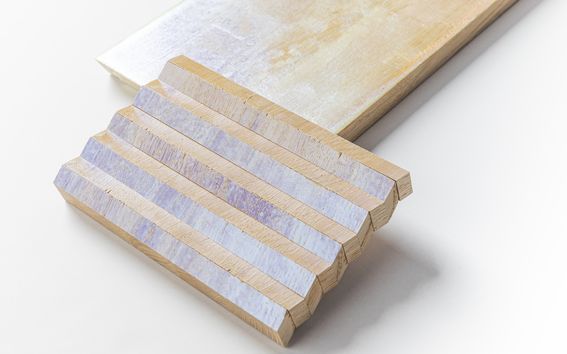
Shimmering Wood - Noora Yau
Biodegradable colours that never fade
Nature’s brightest colours – like those found in peacock feathers or butterfly wings – are created through microscopically small nanostructures. Unlike traditional pigments or dyes, this colour arises only from the physical structure of the material, without the need for chemical compounds. Shiny or glittery effects – prevalent in fashion and design today – are usually created using toxic pigments, plastic-based materials, or metallic foils. This structural colour presents a sustainable alternative to these traditional colourants.
The colour presented here is nontoxic and produced 100% from wood, in an economically viable process. Unlike most existing dyes, structural colour does not fade in sunlight.
Team: Designer Noora Yau, Professor Orlando Rojas & material researchers Blaise Tardy and Konrad Klockars at Aalto University School of Chemical Engineering
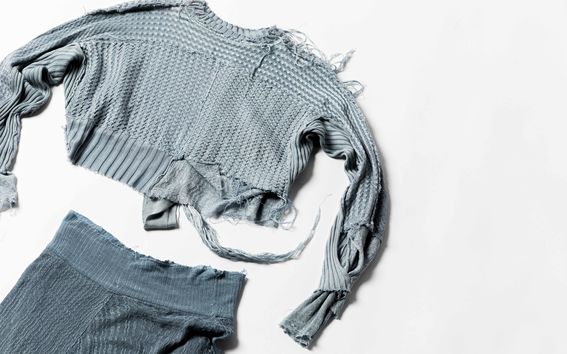
Knits from Wood - Anna Semi
From wood and waste into sustainable textiles
Wood grows in Finland without watering or oversight; in fact, yearly growth currently exceeds harvest and natural loss. Textile fibres made from wood have the potential to reduce carbon emissions, as long lifecycle and recyclability mean that carbon is stored for the fibre’s lifespan.
Ioncell is a new process for producing cellulose-based textile fibres for a circular economy, with a safe, non-toxic ionic liquid. Cellulose-based Ioncell fibre is biodegradable and as a result, does not release microplastics into the environment during the washing cycle. These knitted garments are 100% Ioncell made of birch trees.
Team: Designer Anna Semi & cross-disciplinary Ioncell research team at the Aalto University

To-Matter - Meri-Tuuli Porras
Utilizing side streams from tomato production
Currently, the biomass of stems and leaves from greenhouse cultivation is treated mostly as a waste. In tomato production, side streams cover roughly 20 % of total fresh material, and approximately 30–40 % of dry matter.
Stems and leaves contain a lot of cellulosic fibres which can be used, for example, to manufacture sustainable and recyclable packaging. Farmers could get value out of the biomass by producing their own packaging locally, and reduce their carbon footprint as well. The samples are made of 100% tomato stem waste or tomato stem-wood pulp mix.
Team: Designer Meri-Tuuli Porras & team of material researchers at CHEMARTS lab at the Aalto University.

In Tension - Megan McGlynn
From two-dimensional patterns to three-dimensional shapes
This material experimentation project focuses on shrinkage as an intrinsic quality of drying microfibrillar cellulose (MFC). Encasing geometric tessellations between layers of MFC creates tension in specific directions and produces self-forming curvatures. The encased shapes are 3D printed biodegradable plastic, PLA. The tests include many different patterns, sizes, and drying temperatures. Many of the outcomes are surprising in their strength and peculiarity.
These samples are made of wood-based microfibrillar cellulose (MFC) and nanofibrillar cellulose (NFC), combined with Polylactide (PLA).
Team: Designer Megan McGlynn & material experts from CHEMARTS lab and workshops at the Aalto University.

Plumology - Sini West
Reflections on feather waste
One of nature’s most complex structures can be found in feathers. With a high protein concentration, and possessing technical characteristics such as low thermal conductivity and waterproofness, feathers could be regarded as a versatile evolutionary novelty.
Plumology is a material research project combining chicken feathers and nanocellulose, aiming to remind us of feathers’ value as a biodegradable and renewable raw material for future product design applications. Chicken feathers are a by-product of the poultry industry and currently disposed of in ways which are environmentally and economically unsustainable. Chicken feathers have been ‘glued’ with wood-based nanocellulose, meaning that these prototypes are 100% biodegradable.
Team: Designer Sini West and tutors from CHEMARTS lab at the Aalto University.
CHEMARTS presented first time at Dutch Design Week
Aalto University CHEMARTS is being presented for the first time in Holland at the most important international design event; showcasing new material-related projects. The exhibition runs from 19th–27th of October in Eindhoven and the concepts are based on research conducted by Aalto University students, researchers, lecturers and professors.
The prototypes are a result of continuous and inspiring CHEMARTS collaborations between design, fashion and scientific material research and it's a strategic collaboration in education and research that has taken place between the Aalto University School of Arts, Design and Architecture and the School of Chemical Engineering. The schools combined forces in 2012 with the aim of investing in new ways to harness wood and other bio-based materials. There is now a strong focus on researching the performance and design of advanced cellulosic materials for innovative uses.
CHEMARTS has been selected for DDW Bio-design route, and professor Kääriäinen will give a talk at DDW talks on 23.10.
Dutch Design Week Eindhoven is one of the largest design events in Europe. It presents work and concepts from more than 2,600 designers to more than 355,000 visitors from all over the world.
More information:
CHEMARTS exhibition projects CHEMARTS in Dutch Design Week Dutch Design Week
Contact:
CHEMARTS and exhibition at Veem:
Pirjo Kääriäinen, pirjo.kaariainen@aalto.fi +358 50 381 0217
Anna van der Lei, anna.van.der.lei@aalto.fi
Anna-Mari Leppisaari, anna-mari.leppisaari@aalto.fi
Read more news

Learn to test your startup idea fast – A new From Zero to Product course at Aalto University
The course is open to Aalto students interested in entrepreneurship, startups, and innovation
The School of Business launches its new Bachelor’s major ‘Responsibility and Impact’
‘I’m helping to reimagine what “better business, better society” could become when curiosity leads the way,’ says Associate Professor Taija Turunen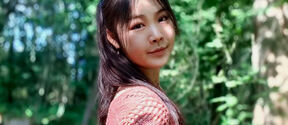
From award-winning food packaging to researching biodesign spaces
From an early age, Ena Naito was drawn to both the sciences and design. She found the perfect place to bring those two worlds together.